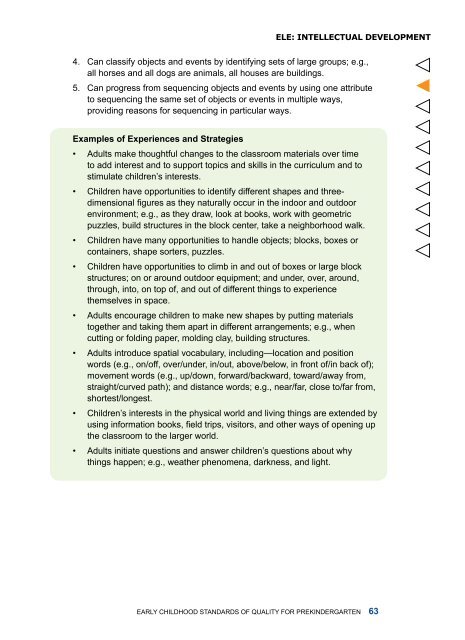Early Childhood Standards of Quality for ... - State of Michigan
Early Childhood Standards of Quality for ... - State of Michigan
Early Childhood Standards of Quality for ... - State of Michigan
You also want an ePaper? Increase the reach of your titles
YUMPU automatically turns print PDFs into web optimized ePapers that Google loves.
ELE: Intellectual Development4. Can classify objects and events by identifying sets <strong>of</strong> large groups; e.g.,all horses and all dogs are animals, all houses are buildings.5. Can progress from sequencing objects and events by using one attributeto sequencing the same set <strong>of</strong> objects or events in multiple ways,providing reasons <strong>for</strong> sequencing in particular ways.Examples <strong>of</strong> Experiences and Strategies• Adults make thoughtful changes to the classroom materials over timeto add interest and to support topics and skills in the curriculum and tostimulate children’s interests.• Children have opportunities to identify different shapes and threedimensionalfigures as they naturally occur in the indoor and outdoorenvironment; e.g., as they draw, look at books, work with geometricpuzzles, build structures in the block center, take a neighborhood walk.• Children have many opportunities to handle objects; blocks, boxes orcontainers, shape sorters, puzzles.• Children have opportunities to climb in and out <strong>of</strong> boxes or large blockstructures; on or around outdoor equipment; and under, over, around,through, into, on top <strong>of</strong>, and out <strong>of</strong> different things to experiencethemselves in space.• Adults encourage children to make new shapes by putting materialstogether and taking them apart in different arrangements; e.g., whencutting or folding paper, molding clay, building structures.• Adults introduce spatial vocabulary, including—location and positionwords (e.g., on/<strong>of</strong>f, over/under, in/out, above/below, in front <strong>of</strong>/in back <strong>of</strong>);movement words (e.g., up/down, <strong>for</strong>ward/backward, toward/away from,straight/curved path); and distance words; e.g., near/far, close to/far from,shortest/longest.• Children’s interests in the physical world and living things are extended byusing in<strong>for</strong>mation books, field trips, visitors, and other ways <strong>of</strong> opening upthe classroom to the larger world.• Adults initiate questions and answer children’s questions about whythings happen; e.g., weather phenomena, darkness, and light.<strong>Early</strong> <strong>Childhood</strong> <strong>Standards</strong> <strong>of</strong> <strong>Quality</strong> <strong>for</strong> Prekindergarten 63


